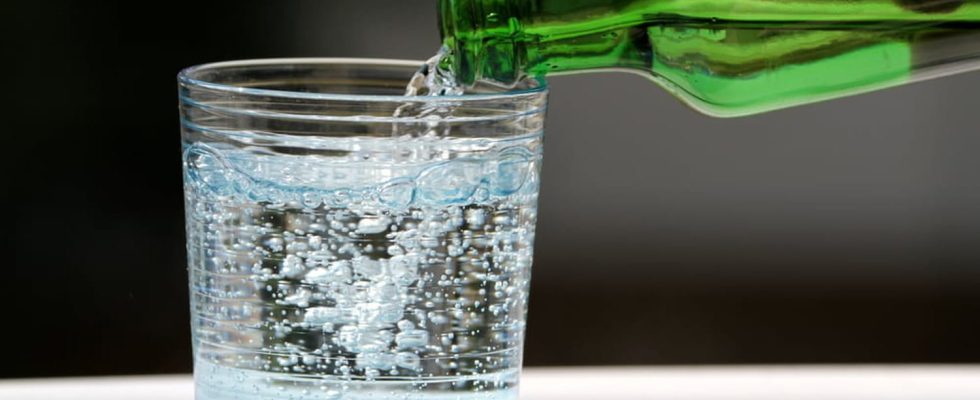Constantly drinking carbonated water leads to various consequences for the body, some positive and some negative, which are important to know.
Water represents 60% of the weight of the body and this high percentage testifies to the crucial importance of this element for the health of our organism. Staying hydrated by drinking enough water each day is essential to ensure the proper functioning of various functions, such as digestion and maintaining body temperature.
However, not all waters are the same and knowing them can help to choose the one that suits us best. The main distinction is between still water and sparkling water. Those who find it difficult to drink the minimum daily amount of water often tend to opt for carbonated water, which they perceive as more pleasant, but it is not necessarily the best option in the long term.
Still water comes naturally from springs and does not undergo any treatment. To obtain carbonated water, carbon dioxide is artificially added to still water, which creates the characteristic bubbles.
Drinking sparkling water provides a feeling of freshness and immediate pleasure in the mouth, which is why it is more often chosen in summer or when you feel the need to quench your thirst more.
Carbon dioxide in itself is not harmful to the body and therefore it is incorrect to claim that drinking carbonated water is bad for your health. On the contrary, it would have several positive effects. The first is that it aids digestion. Bubbles, i.e. carbon dioxide, stimulate the production of gastric juices, thereby facilitating and accelerating gastric emptying.
Sparkling water would also increase the feeling of satiety. Especially if drunk before meals, it noticeably reduces hunger because carbon dioxide fills part of the stomach.
Finally, sparkling water is particularly rich in minerals such as magnesium, calcium, potassium and sodium.
Although carbon dioxide is not harmful on its own, excessive consumption of carbonated water can lead to certain problems. The first is abdominal swelling, sometimes accompanied by pain and gastric distension.
The bubbles can in fact cause the gastric walls to dilate. This effect is harmful for everyone, but especially for those who suffer from gastroesophageal reflux disease, whose symptoms could worsen.
Other pathologies are also not compatible with the consumption of carbonated water. People with ulcers and gastritis should avoid drinking it to avoid the risk of aggravating their symptoms.
Finally, drinking carbonated water over the long term can damage tooth enamel, again due to the action of the carbon dioxide it contains.
In addition to the presence of carbon dioxide which characterizes carbonated water,
the waters are also distinguished by the value of the dry residue, which indicates the concentration of mineral salts and trace elements present in one liter of water.
To determine this, the residue left by a liter of mineral water evaporated at 180° is analysed.
According to this classification, the waters are divided into different categories:
- Waters with low mineral content: these waters contain up to 50 milligrams of dry residue and are considered light. They promote diuresis and the elimination of small kidney stones.
- Oligomineral waters: these waters are low in mineral salts, in particular sodium, which are present in varying quantities from 51 to 500 milligrams per litre. This characteristic makes them perfect to be drunk daily at the table, and that is why they are the most common. In addition, they stimulate and improve diuresis. They are particularly recommended for people suffering from chronic kidney failure, water retention and for those on low sodium diets. They are also ideal for drinking by young children and for adding to powdered milk, as they do not alter the value of the nutritional components of this precious food for the growth of infants.
- Moderately mineralized waters: these waters contain 501 to 1,500 milligrams of dry residue per litre, and the presence of mineral salts is therefore higher.
- Waters rich in mineral salts: these waters contain more than 1,500 milligrams of dry residue per litre. Being very rich in salts, they are often used for curative purposes and only on medical recommendation. Their high capacity to reintegrate liquids and minerals lost through perspiration also makes them particularly suitable for athletes, during physical activity or during the warmer months.
Depending on the quantity of mineral salts, the waters are also classified as bicarbonated water (calcium > 600 mg/l), sulphated (sulphates > 200 mg/l), chlorinated (chloride > 200 mg/l), calcic (calcium > 150 mg/l), magnesium (magnesium > 50 mg/l), fluorinated (fluorine > 1 mg/l), ferruginous (iron > 1 mg/l), sodium (sodium > 200 mg/l) and hyposodium (sodium < 20mg/l).
In conclusion, although carbonated water can benefit your body, it is important to consume it in moderation and consider the other types of water available to meet your body’s needs.
